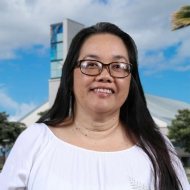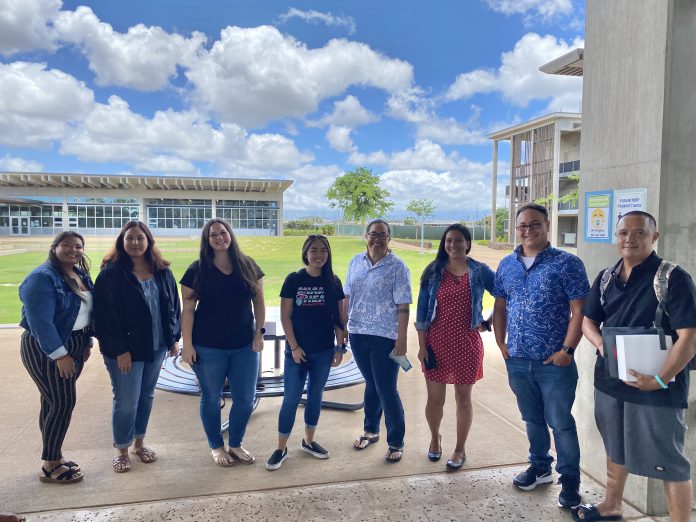Create a pathway for teacher candidates — not just into the University of Hawaiʻi–West Oʻahu, but out of UH West Oʻahu and back into the communities. Empower these teachers who are rooted in their communities. Provide them with opportunities to increase Hawaiian cultural knowledge in their classrooms.
These are among the goals of the Hoʻopūliko Kumu Hou Educational Pathway Project (HKH), a $2 million, five-year Title III grant running from Oct. 1, 2019, to Sept. 20, 2024, at UH West Oʻahu. The project is currently in its third year.
“ ‘Hoʻopūliko’ means to send out shoots and ‘Kumu Hou’ is the word for new teachers,” said Cathy Ikeda, director of the HKH program at UH West Oʻahu. “So we are growing and sending out shoots of new teachers on this educational pathway from the high schools and community colleges to UH West Oʻahu and back out into the communities.”
Ikeda will discuss Hoʻopūliko Kumu Hou at an “On the Horizon” webinar titled “Kanu Kumu O Ka ʻĀina: Planting Teachers of the Earth,” which is scheduled for 11 a.m. on Thursday, Oct. 28, via Zoom. Register for the webinar here. She will be among the guest speakers at the event, which is part of a series presented by the UH Office of Alumni Relations and UH Foundation that aims to showcase programmatic endeavors, campus goals, and opportunities for support at UH’s 10 campuses. Event details are forthcoming.
HKH is funded by Title III, a Native Hawaiian/Alaska Native grant opportunity with the U.S. Department of Education.
Ikeda, who is also an associate professor of Middle Level and Secondary English with the Education division at UH West Oʻahu, said the grant helps UH West Oʻahu to partner with other stakeholders in this region to significantly increase the number of Native Hawaiian and part-Hawaiian teachers earning their bachelor’s degrees and entering the region’s secondary classrooms in the next five years.

“The middle/secondary education program (at UH West Oʻahu), through its practicum courses, is a Hawaiian culture-based education (HCBE) program, so the grant also helps to enhance and expand that aspect of the program,” Ikeda said. “The intention to not only be a grow-your-own program, but also a Hawaiian culture-based education program, is a critical strategy to end the cycle of attrition afflicting Hawaiʻiʻs public schools, especially in the HIDOE complexes around UH West Oʻahu.”
The vision of HKH is to expand and sustain a vibrant grow-your-own, HCBE secondary preservice teacher program. Its four main objectives are to:
- establish and maintain strong partnerships that increase UHWOʻs production of teachers;
- expand the secondary preservice teacher program;
- implement and refine the HCBE foundational curriculum; and
- develop and refine a system of student support to address barriers facing minority and underrepresented teacher candidates.
By the numbers
The intention of the Ho‘opūliko Kumu Hou program is to graduate 102 new secondary teachers within the five years of the grant.
The secondary education program at UH West Oʻahu is fairly new, Ikeda noted. The first secondary teachers graduated in spring 2017. There were three graduates. In spring 2018, there were seven graduates. In spring 2019, there were 10.
“So pre-grant, we graduated a total of 20 students in three cohorts,” she said.
In year one of the grant, 11 secondary teachers graduated in spring 2020. In spring 2021, there were 15 secondary teachers who graduated. In spring 2022, 13 secondary teachers are set to graduate with 15 candidates right behind them for spring 2023.
“We are not quite there,” Ikeda said of the numbers. “This pandemic has been difficult in that most of our recruitment happens in face-to-face conversations at the schools. That did not happen this year and we saw our numbers go down. However, we are seeing sustainable progress and growth.”
Benefits of grow-your-own programs
“Teachers in grow-your-own programs know the lived reality of their students and are products of the same community schools, which gives them kuleana to support the community and build relationships with the students, so I am proud of these numbers,” said Ikeda, referring to the following table she shared:
| School | Number of UHWO alum teaching at that school | Number of teachers who graduated from, attended, or live in the community of their school |
| Waiʻanae/Nānākuli Complex | ||
| Waiʻanae High | 4 | 4 |
| Nānākuli High/Inter | 2 | 1 |
| Campbell/Kapolei Complex | ||
| Kapolei High | 1 | |
| Kapolei Middle | 4 | |
| Honouliuli Middle | 3 | 1 |
| ʻIlima Inter | 1 | 1 |
| Campbell High | 7 | 6 |
| Central District | ||
| Waialua High/Inter | 2 | 2 |
| Wahiawa Inter | 2 | 1 |
| Leilehua High | 3 | 2 |
| Mililani Middle | 2 | 1 |
| Mililani High | 2 | 2 |
| Waipahu Inter | 1 | 1 |
| Highlands Inter | 1 | 1 |
| Honolulu District | ||
| Farrington High | 1 | 1 |
| McKinley High | 1 | |
| Roosevelt High | 2 | 1 |
“I think part of the expected outcomes of the grant is in the table above — create a pathway not just into UH West Oʻahu, but out of UH West Oʻahu and back into the communities,” Ikeda said.
What the program is seeing in the current year three is an ability to bring alumni back from the year one cohort and have them present at the upcoming fall intercession “Build a Teacher” workshop, Ikeda said, which is geared towards high school students interested in teaching, as well as students at the community college who want to transfer to UH West Oʻahu in the education program.
This October, four early career teachers who graduated in spring 2020 from UH West Oʻahu are scheduled to present on how they continued to be Hawaiian culture-based practitioners through their first year of teaching even when their students were online, and then how they are using what they learned last year to inform how they teach in person.
“Creating opportunities for our alum to mentor the candidates below them is not in our grant, but during year three, it is a way to continue the pathway and create sustainable practices that can continue beyond this grant,” Ikeda said.
